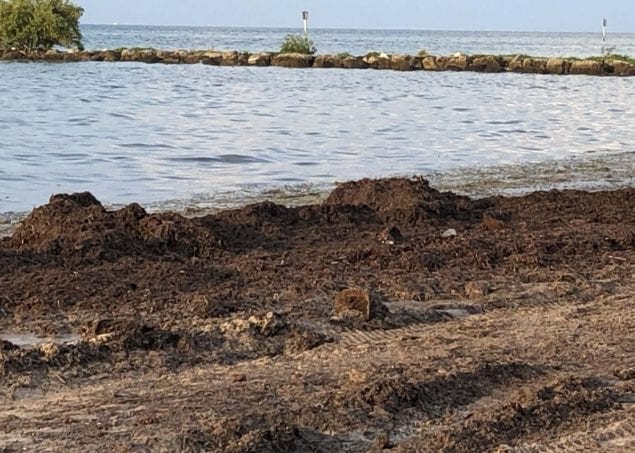|
Getting your Trinity Audio player ready...
|

You can see sargassum seaweed seasonally at Florida beaches, but its economic impact on municipal budgets, tourism and coastal communities is felt year-round.
One solution might be to use the seaweed for compost, say researchers with Florida Sea Grant and the University of Florida Institute of Food and Agricultural Sciences (UF/IFAS).
A pilot study, funded by Florida Sea Grant at UF/IFAS Extension, is underway to evaluate if the brown sargassum collected from beaches can eventually be used as compost. If successful, it could transform the current costly removal of the seasonal mounds that wash up on the Sunshine State’s Gulf and Atlantic beaches into a landscaping option for municipalities and for residents in coastal areas affected by the influx of this material.
“Before we can determine if sargassum can be used for compost or a topsoil amendment, we need to determine the chemical composition and if it is too salty for a safe compost,” said Shelly Krueger, a Florida Sea Grant agent at UF/IFAS Extension Monroe County.
Sargassum has been repurposed in the past in other countries and states for a variety of uses, but recent studies from Mexico and Texas have given rise to concerns after elevated arsenic levels were recorded in sargassum samples.
“As far as we know, there have been no studies in South Florida to determine the level of arsenic in sargassum that washes up on our beaches,” Krueger said. “The forms of arsenic found in sargassum are not harmful to humans unless ingested; however, it is largely unknown how it accumulates in soils or how it could accumulate in plants, for example.”
The goal of the study is to determine whether sargassum can be used as compost for landscaping. UF/IFAS scientists will test the quality of sargassum compost, compare sargassum to local yard mulch such as community tree trimmings and quantify the arsenic content of sargassum compost.
For the first part of the study, researchers collected large amounts of sargassum during last summer’s wave of sargassum on the beaches of the Florida Keys, including Smather’s Beach and the city of Key West. During that time, Florida Sea Grant agent Vincent Encomio led a team that collected a second set of small samples for arsenic testing along the Treasure Coast.
That collection of samples was drawn from Fort Pierce Inlet, St. Lucie and Martin county beaches. Additional samples were collected from Grayton Beach State Park in the Panhandle, Cocoa Beach in Brevard County and Miami Beach located in Miami-Dade County.
“The plan is to compare and analyze the samples collected and then hold another collection during the early season in June 2021 to compare numbers and begin the larger-scale composting experiment,” said Encomio.
Sargassum provides numerous ecological benefits in the ocean, but when it accumulates in large quantities on beaches as it has been since 2011, it can trigger negative effects to the shorelines and the environment.
Currently, most counties and municipalities are paying for the sargassum to be collected, transported and paying tipping fees to construction and demolition landfills on the mainland. Tipping fees in Monroe County are already almost three times the national average at $146 per ton so this additional mass is costly to the county. In 2019, Monroe County spent $150,000 on sargassum removal.
The Miami-Dade Parks Department estimated daily removal of sargassum along 15 miles of beaches would cost $45 million a year; instead, the county has targeted four hot spots at a cost of $3.8 million per year.
“Knowing how to safely and effectively dispose of and repurpose sargassum will be valuable to counties and residents,” said Ashley Smyth, the study’s principal investigator and a scientist at UF/IFAS Tropical Research and Education Center in Homestead. “The arsenic concentration of sargassum has yet to be studied in south Florida. Until local data are available, we don’t know if we can safely compost sargassum and municipalities will continue to spend extra money transporting sargassum to hazard waste facilities.”
To that end, local agencies and sites have partnered to support the pilot study. Entities include Key West Botanical Garden, serving as an experiment site, along with the collaborations from the city of Key West assisting in the collection of the sargassum. Monroe County’s collaboration will add to Monroe County Sargassum Management Plan.
Results of the pilot study and the final report will be shared with interested communities, including resiliency and solid waste managers with city of Fort Lauderdale, Sarasota, Collier, Miami-Dade, Indian River and Monroe counties.





